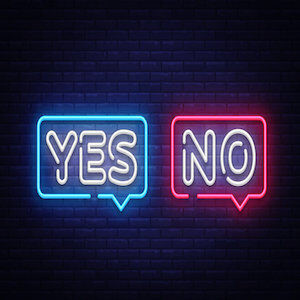By Dr. Ken Broda Bahm:

It sometimes happens in the course of testimony: After what might have been a longer or misdirected answer, the witness will receive a stern admonition from either the questioning attorney, or worse, the judge: “Please listen carefully to the question and then simply answer ‘Yes’ or ‘No.'” That kind of penalty flag on the play can be a bit of a confidence killer, and it can reduce the witness’s credibility in the jury’s eyes, particularly when it comes from the judge. Of course, the court and the questioning attorney have a right to that direct answer, but, in my view, the witness also has a right to place their answer in context, to make any necessary qualifications, and most basically, to testify in their own words. The strict “Yes or No” takes that away.
I have written before that there are many ways a well-prepared witness can answer substantively that go beyond the restricted “Yes or No” that opposing counsel is looking for. But using that freedom depends on avoiding an instruction from the judge that boxes you into a one-word answer. Generally, that will happen when a witness has gone too far and is either not giving a direct answer, or is wandering far from the parameters of the question. Witnesses who obviously or clearly drift from or resist the question can expect to be shut down. In my view, avoiding that situation comes down to following three golden rules that I’ll outline in this post.
1. Make Sure You’re Answering and Not Rambling
That’s the first and most essential requirement: Do what the court and counsel have a right to expect you to do – answer the question. Often an unpracticed witness feels like they’re answering the question, but they’re skimming over the meaning, listening for the topic rather than the question, and supplying information that has not been directly requested. It takes preparation and immediate feedback, but with time the witness should know how to be specifically responsive, and not just generally relevant. The question creates a fence — stay inside that fence. You can be complete and can choose your own words within that fence, but don’t climb over the rail and wander into an adjacent field.
2. Put Your Direct Answer First
If the question is, “Are you involved in Smithco’s hiring process?” and the witness begins with, “At Smithco, the way the hiring process works is…” what follows may indeed be relevant to the question, and the witness may even come around to giving an answer. But beginning with something other than a direct “Yes,” “No,” “Sometimes,” or “It Depends” risks frustration on the part of the questionner, and that frustration can infect the judge and jury as well. The witness who begins with background information also risks being cut off before they get to an answer. So feel free to add context or to qualify, but let that explanation follow a direct answer to the question. Answer first, then explain.
3. Keep the Explanation Short
Sometimes an explanation is necessary, but don’t let that be a license to ramble, to answer questions that were not asked, or to jump into a new topic. Often the length and the substance of the explanation is a judgment call, and it takes practice for the witness to find the sweet spot in between “too little” and “too much” when it comes to their own words. As a general rule, in cross-examination witnesses should stick to a single sentence. I have also heard it expressed as the “one breath rule,” meaning if you are pausing to reload your lungs, then chances are good that you’re saying too much and drifting beyond the question. This means that the fully detailed explanation may need to wait, and that is okay. In cross-examination, jurors just need to know that there is an explanation — fully understanding it can wait for direct or re-direct.
Of course, a judge who is having a bad day can still shut down a witness who is doing their best to be responsive in their own words. And, clearly, if a judge does insist on limiting the witness to just “Yes” or “No,” then the best they can do is to comply now and explain later in response to more open-ended questioning from their own lawyer. But typically, the full shut-down occurs in response to a witness who isn’t clearly answering: Follow these three rules, and you minimize the chances of that constriction.
Other Posts on Witness Response Options:
- Witness Preparation: Teach the Second Level of Response
- The Reptile Question: Give a Good Answer
- Witnesses, Return to Your ‘Home Base’ Where Possible